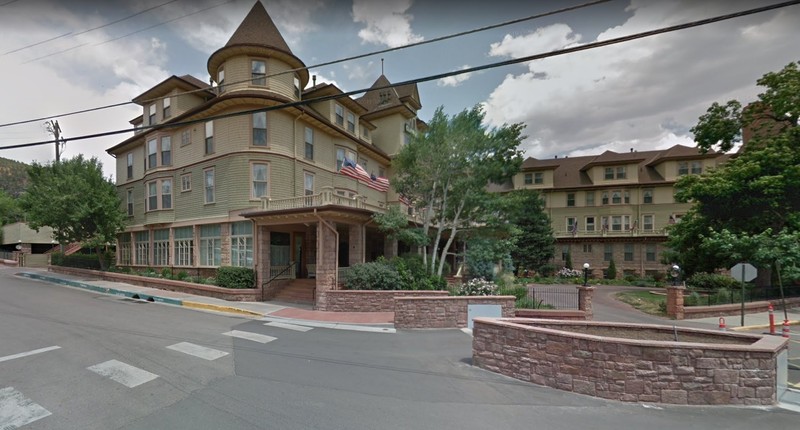The Cliff House 1874
Introduction
Text-to-speech Audio
The Cliff House gained prestige as the finest hotel in Manitou Springs and has had numerous famous guests. A pioneer named Keener built the original Cliff House in 1873 as an inn for summer visitors traveling on the stages of the Leadville Stage Company. Edward E. Nichols, Sr. a founding father of Manitou leased the inn from Keener in 1876 and named it Cliff House simply because it was near a cliff.
Images
The Cliff House

Backstory and Context
Text-to-speech Audio
Nichols came to Colorado to recover from tuberculosis (like thousands of others). He liked the weather, and after four years bought Keener's building outright, but kept it as a summer hotel. Nichols successfully built on the tourism of the vacationing eastern city folk, first identified by William Palmer and Dr. William Bell in the 1860s. Just before the turn-of-the-century, E.E. Nichols, Jr. succeeded his father.
Both Nichols Sr. and Jr. used two very busy local brothers, Archie and Angus Gillis, as contractors on the changing façade and constant interior remodeling. By 1920, the building contained 265 rooms. Capitalizing on his father's reputation, Nichols Jr. attracted the finest family names in America. Those we would remember today would be the Armours and Swifts. They brought entire trainloads of trunks and stayed at the Cliff House for the full summer season.
In 1916, E.E. Nichols, Jr. opened the Cliff House year round. Thomas Edison, a distant relative of Nichols visited about then, just in time to see his invention--electricity--be put to use in the Cliff House.
The architecture is a composite of styles and additions. It began as a simple hipped roof building, with two separate buildings added to the west and the east. At least half a dozen renovations took place over the five Nichols' decades. The stone first floor was topped by shake and clapboard siding on the second and third floors. It boasts bay windows with turreted towers on the ends and dormers brothers' restoration. Ballastered porches grace the first and second stories, creating a Victorian Queen Anne beauty.
The Nichols family kept the Cliff House in operation until 1948 when it was sold and divided into apartments. The north wing was dismantled in 1968. A disastrous fire nearly destroyed the National Register building in 1982, however the fire departments from throughout the region answered the call. The second and third floors were reconstructed to a level to prevent further deterioration. The structure sat through the remainder of that decade vacant and in need of rehabilitation.
Sources
Historic Manitou Springs, Inc., is an educational non-profit based in Manitou Springs, Colorado, at the foot of Pikes Peak which operates the Manitou Springs Heritage Center and was formed in 1997 as a 501(c)(3) nonprofit.
Our mission is to collect, preserve, research, and interpret the history and culture of Manitou Springs and the Pikes Peak Region.
The intent of the organization is to educate citizens and visitors in order to increase appreciation and understanding of this unique community. Before opening the Center Historic Manitou was operated by a board of three persons–Jean Garrity, Deborah Harrison, and Michelle Anthony. During the initial 10 years, we developed a track record of participating in and supporting community projects and events, such as restoration of the Eastern Gateway Arch, rehabilitation of Mansions Park, installation of over 30 Historic Interpretive Plaques throughout town, and placement of the memorial in Crystal Valley Cemetery for Emma Crawford. We have presented the “Ghost Stories of Old Manitou” haunted walking tours as part of the Annual Emma Crawford Festival (i.e., the events surrounding the Coffin Races) since its inception.
Pearring, John. Pearring, Joanne. The Walking Tour - A Guide to Historic Manitou Springs. Volume Revised Printing. Manitou Springs, CO. TextPros, 1998.
https://www.google.com/maps
